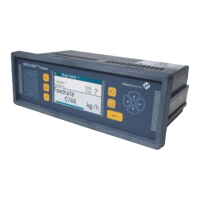Startup operation
BV-H2464GB, 1234
- 46 -
INTECONT® Tersus Belt weigher, Instruction Manual
Schenck Process Group
F = Qo * L * H * cos(a)
Qo
Nominal Belt Load
P04.01 kg/m
L
Effective Platform Length
P03.05 m
H
Lever Ratio
P03.06
a
Angle
P03.07 Degrees
F Force on the load cell kg
F should be less than or equal to the total of LC Rated Capacity P03.04. Otherwise, the load cells are too
small for the required Nominal Flow Rate.
12.3
12.312.3
12.3
Function Check
Function CheckFunction Check
Function Check
1. Switch on the belt conveyor and scales. The switch-on process depends on the preselected Feeder
Start P02.06 source.
2. A rotating cross appears in the header as a progress indicator. If not, there is no clearance or the ON
button was not pressed.
3. Take any event messages which appear into account and remove the error.
4. Check the following:
Tachometer: The output frequency of the tachometer generator has to be less than 3,000 Hz with acti-
vated measurement. The value must approximately correspond to the information in the data sheet.
Load cell: The non-standardized initial value for the load cell amplifier may not be larger than
2.85 mV/V even at nominal load of the weighing platform. It must change if the weighing platform is
placed under load (e.g. the calibration weight). If the value is too large, the load cell is overloaded. If the
value is negative, the load cell may be wrongly connected.
The load cell load in percent, sourced from the sum of the load cell nominal capacities, should not be
larger than 100 % with nominal belt load.
12.4
12.412.4
12.4
Test With Calibration Weight
Test With Calibration WeightTest With Calibration Weight
Test With Calibration Weight
The test with a calibration weight makes sense because
1. mechanical or electrical faults are possible
2. calibration data can be unreliable (for instance, the leverage is not precisely known) and it is difficult to
measure the belt inclination
3. data may be incorrectly entered
The calibration weight should be between 30 % ... 100 % of the platform nominal load and be accurate.
1. Enter Calibration Weight P03.08.
On beltweighers with parallel leaf-spring guides, the effective calibration weight is the same as the ac-
tual value. In other cases, the effective calibration weight can be taken from the data sheet, or can be
calculated according to the chapter details/data flow images. The inclination of the conveyor belt has no
effect on the effective calibration weight.
2. Call up the CW: Span Calibration program.

